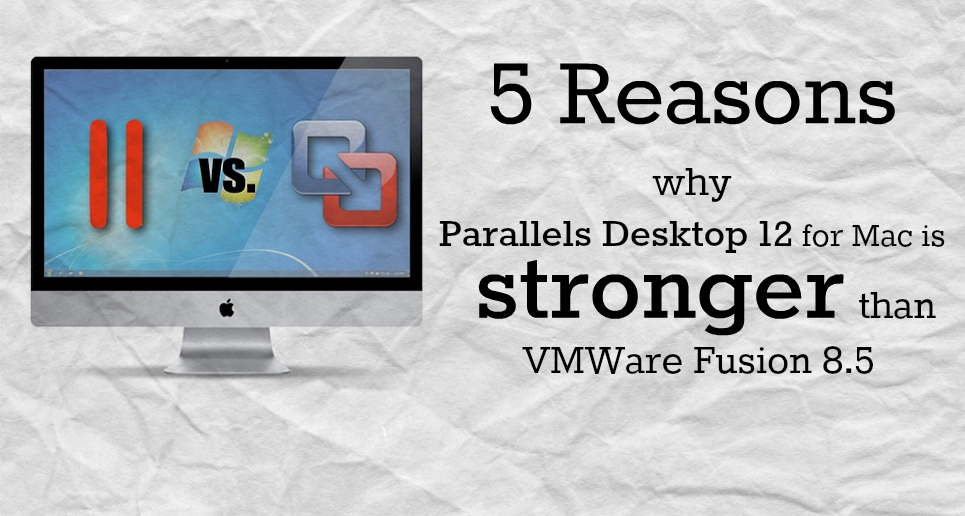Parallels Or Vmware Fusion For Mac
My sister-in-law designs commercial landscapes for a living, and while she loves a Mac, she prefers the PC version of AutoCAD. She used to own a 27″ iMac with 32 GB of ram with a 1 TB Fusion Drive, and AutoCAD would consistently crash on it. On a much slower PC, AutoCAD was far better. I say all of this to say – there are countless reasons why you might want to virtualize Linux, Windows, or macOS on your Mac.
Parallels Or Vmware Fusion For Mac 2017
This was in the days before SSDs were as common, remember, and that will make a world of difference. Fusion also had some more corporate-focused functions at the time, although Parallels did have some Bootcamp migration tools that Fusion did not, as I recall. Fusion was also the first to market with the 'Unity' interface whereby your Windows UI was 'melded' with your OS X UI. That was HUGE for me when I was juggling classes, clients, and platform-specific software on both OS X and Windows. After that it was a matter of least resistance (and cost) to keep Fusion, and it's always been zippy for me. Now, however, after having seen how well Virtualbox handles Server 2012R2 and Windows 10, along with its expanded feature set, I'm moving there. For example, you can chose which format you'd like the disk image in, some more nuanced networking options, etc.
But run OS X as a guest and it all goes to hell Although it's usable, even at with 'Use full screen for Retina display' checked to make use of the non DPI. Fusion doesn't use for double scaling (Yes. Everything is super small) even at full screen refresh rate in Guest OS X feels almost like booting 'Safe boot' on Mac, excluding the visible refresh lines. I'm currently using Fusion on my new to me late 2013 rMBP 15'. I've got an install of Win.

Vmware Fusion
Running the current generations of these two virtualization programs—Parallels 8 Desktop for Mac () and VMware Fusion 5 ()—on one of today’s ultrafast Macs, only the most hardcore Windows.
Worse, the entire system feels slower than Parallels. Even on an iMac Pro, Unity mode will stutter and have to redraw windows instead of smoothly animating them. Boot Camp As virtualization — running Windows inside a macOS app — lets you use both macOS and Windows at the same time, it’s probably the best option for most people. The convenience of having your one or two must-have Windows apps right next to the data and apps on your Mac is hard to beat. However, virtualization comes with a price: computational overhead. How to use find and replace in word for mac.
It's RESTful and built using Golang and Swagger. We just made it available in our ( free!) 2017 Tech Preview which you can check out here: • We support Microsoft VBS and Credential Guard in the Tech Preview, I don't believe other mac-based hypervisors do currently without some (probably unsupported) hacking. • Veertu actually exited the Mac desktop space and pivoted with a new name to focus on CI for iOS, so that's probably not a viable option any more. Happy to answer any other questions, cheers! -Michael Roy -- mroy at vmware dot com.
Once each system got started, however, both ran real-world applications like Word and Excel at just about the same speed. That is to say, they ran more sluggishly than the native macOS versions of those apps, but certainly fast enough to be usable. Fusion is part of the corporate-level VMware family of products, so any virtual machine you create with VMware Workstation on a Linux or Windows machine will also run under VMware Fusion on a Mac, and any virtual machine you create in Fusion will also run under VMware Workstation. Visio 2017 download. Parallels, in contrast, only has a Mac version.
Flip pdf for mac review. Flippagemaker.com - The Best way to convert PDF to digital page turning publications, magazines, brochures and catalogs.
I don’t mind some limited sharing, but I want there to be a clear separation. Performance & Utility It’s hard to measure the speed of virtual machines. Your mileage will vary based on what computer you have, how much RAM it is equipped with, and more.
I'm back on the 'spend money only if really need be' plan, so I'd have to really be sold on VMWare to pay for it. Notes on my use: I do not play games in VMs, except I did do test runs of some legacy Windows XP compatible games in a VMWare instance back a few years ago when I first got Fusion. I create 'pure' VMs in that I don't want features from the host OS to bleed through into the VMs themselves. Other than having a few folders set up for sharing files into the VMs, I don't want ANY features or menus or even 'looks and feels' to bleed through. I do use VM for business in the following way: I create a VM of each Windows version I do support work for. I then test install software and use the VMs to mimic/recreate issues that my users report to me. I picked both VMWare fusion and 'Other' because VMWare offers EXSi as well as the main goal.